Agentic AI in Healthcare- Research Guide 2025

Artificial intelligence has long been reshaping industries with its exceptional capabilities of automating tasks while reducing human errors and enhancing the overall experience. In such a scenario, healthcare has also undergone a significant transformation by leveraging smart patient management systems to intelligent bots. However, now we are entering the era of “Agentic AI,” where things are getting even more advanced. Now, you don’t need to feed data to your AI system, but it will automatically learn from the user interaction and experience. Similarly, the new system doesn’t automate the task but the entire process.
A multi-modal large language model is one of the core contributing technologies in the evolution of healthcare by the use of agentic AI solutions. Whether it is drug discovery or providing personalized patient care, agentic AI is capable of performing the tasks in a way that could only be imagined by many like us. While the ethical concerns regarding the use of agentic AI in healthcare have gained momentum every now and then, the benefits leveraged with the use of this technology by healthcare professionals can never be neglected. For instance, it has become extremely easy to analyze medical visuals like X-rays and CT scans to identify fractures, tumors, and more. Similarly, the systems are highly capable of monitoring real-time patient health and symptoms to accurately predict potential diseases. At the same time, it even curates a personalized care plan that can help reduce the symptoms.
A Glance into the History of AI in Healthcare
If you think of AI applications in healthcare as a new and modern concept, you might be wrong. The traces lead us to the 1970s when things began with a rule-based system like MYCIN, QMR, INTERNIST-1, DXplain, and more. These systems proved to be highly helpful in addressing the medical challenges, but could not withstand the changing complexities in the sector.
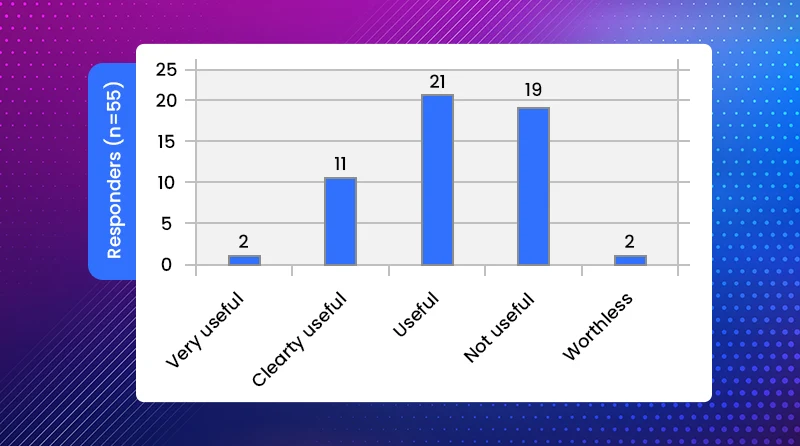
Source: https://www.researchgate.net/
However, by the 1990s, the computational capacity increased, advanced machine learning algorithms evolved, and innovators had access to large healthcare datasets. All of these helped significantly to move toward data-driven approaches. As soon as the technology evolved, machine learning researchers and medical professionals collaborated to introduce healthcare-related automation.
The decade of the 2000s came with the evolution of deep learning that further catalyzed the process. Deep learning played a big role in introducing medical imaging, in which convolutional neural networks enabled image segmentation, anomaly detection, and classification. The innovation enormously enhanced the diagnostic precision, prognostic prediction, and brought trust of people in AI innovations for better healthcare.
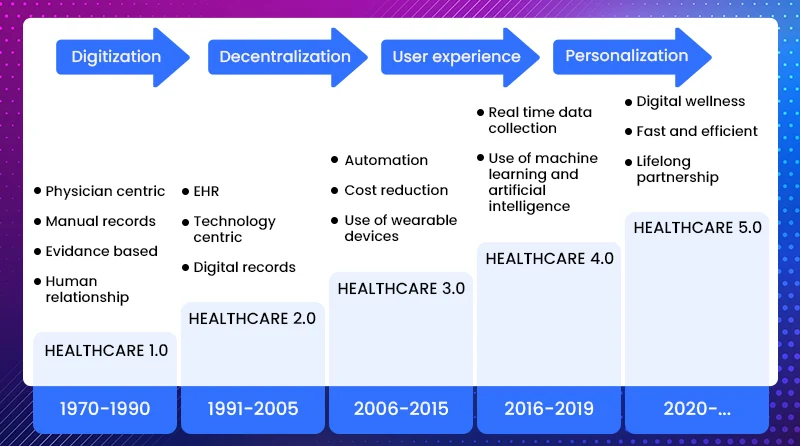
Key Statistics for Agentic AI in Healthcare
The agentic AI in the healthcare market was valued at $538.51 million in 2024. The market is currently growing with a compound annual growth rate of 45.56% (which is a rare number, considering the growth rate of other similar technologies and markets) to achieve the valuation of $4.96 billion by the end of 2030.
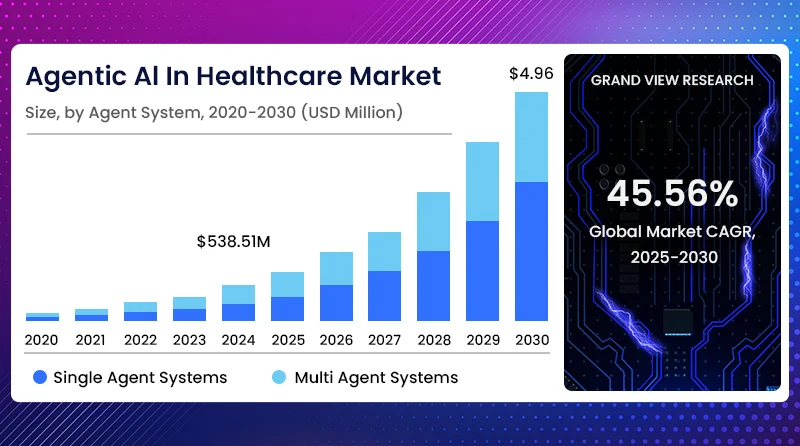
The statistics signal clearly about the burgeoning preferences of the healthcare institutions toward the agentic AI solutions to elevate precision while increasing efficiency. Automation is not the sole driving factor behind the use of agentic AI in the healthcare sector, but its role in surgery, visual analysis, personalized patient care, resource optimization, and compliance control is also the big catalysts that encourage the use of agentic AI in the healthcare sector.
Talking about the market share, North America seemed to be leading the agentic AI in the healthcare market with its impressive share of 54.85% in 2024. On the other hand, when looking at the penetration rate of technology in the market, it can be observed that the Asia Pacific is showing the fastest-growing rate. India and China have been the biggest contributing factors to the growth, as the healthcare institutions in both countries are consistently exploring innovative ways of implementing intelligent technology into their operations to further elevate their care standards.
Among the different types of agentic AI systems, the single-agent system has dominated the market with its largest revenue share of 60.04%. This system is designed by integrating only a mono AI agent that is trained to perform a particular task without requiring human support or intervention. At the same time, it is also trained enough to make decisions and execute the particular course of actions while taking care of results and pre-defined goals.
Moreover, moving toward the product type, it has been identified that the ready-to-deploy agent segment marked the biggest revenue share of over 64.18%. The number clearly indicates that businesses prefer agentic AI solutions with the least time-to-market to embrace the competitive advantages. The advantages, like rapid implementation ability, enhanced decision making, and easy scalability, also make ready-to-deploy agentic AI solutions the primary choice of healthcare institutions globally.
Among the different types of agentic AI applications, the medical imaging segment holds the largest market share of 19.13%. These kinds of solutions are highly used by hospitals, clinics, and research centers to elevate their image analysis standards, reduce interpretation times, and enhance diagnostic accuracy. Tasks like analyzing X-rays, CT-scans, and MRIs become extremely easier as agentic AI solutions are designed to accurately identify tumors, fractures, and other medical conditions. At the same time, these solutions can also identify the internal organs’ condition to accurately predict the risks of different types of diseases in early stages.
The Tech Infrastructure and Working Mechanism of Agentic AI Solution
Tech Architecture of an Agentic AI Solution
Agentic AI solutions are often dependent on the integrated deep learning encoders that help to process multimodal data, including texts, images, and other visuals. This encoded data is then processed by the central large language model that functions as the decision-making and reasoning core of the agent.
Some of the most commonly used large language models in this arena are Falcon, LLaMA, and Vicuna, which are trained on large-scale datasets. The flexibility of these large language models makes it easy for developers to build their personalized AI agents while ensuring better transparency, shaping the decision-making process, and thoroughly understanding the internal reasoning.
On the other hand, if the proprietary large language models like Gemini or ChatGPT are used to build the agentic AI, it can undoubtedly offer enhanced and more optimized performance with broader support, but the overall solution might have to compromise on transparency and their internal decision-making procedure.
There are multiple key mechanisms that are used by these central large language models, like chain-of-thought (CoT), tree of thought (ToT), and reasoning and acting (ReAct). These techniques play a core role in enhancing the decision-making and reasoning capabilities of the solution via structured decomposition, contextual understanding, and logical inference.
The adaptability and modularity of agentic AI solutions are highly helpful in ensuring the seamless integration of deep learning models, large language models, and many other AI components. The modular architecture not only supports seamless integration but also enhances the flexibility of the solution to adapt according to evolving tasks while ensuring the deployment across multiple domains.
Key Technologies in an Agentic AI Solution
Agentic AI is the most advanced version of artificial intelligence applications in modern times, which helps to streamline and automate the entire process. The complete architecture of the solution is powered by numerous technologies that bring certain capabilities into the solution. At the same time, these technologies are also the core building unit of the agentic AI software that helps build the overall infrastructure of the solution. Here are the key technologies that agentic AI solutions incorporate-
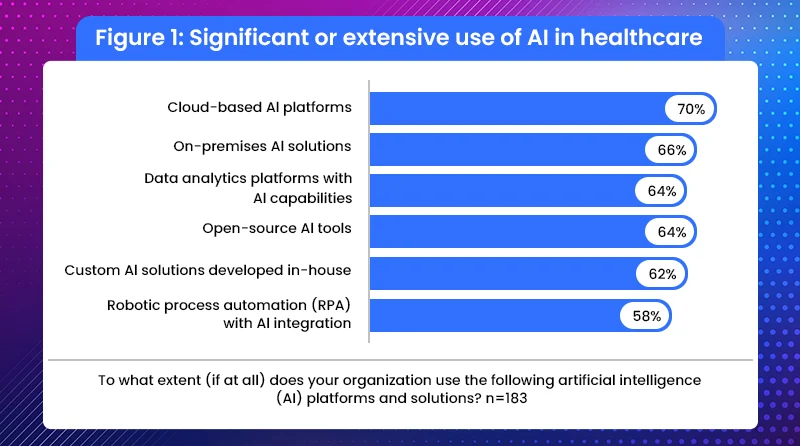
Large Language Model
A large language model plays the part of a brain in agentic AI solutions that offers the capability of understanding, planning, and reasoning for the solution. The LLM technology helps significantly in interpreting complicated instructions, making decisions, analyzing data, and communicating. However, there are still limitations in real-time knowledge gathering and memory setups that require the large language models to integrate the external tools and memory systems so that the autonomous agent can perceive, reason, plan, and act to achieve the predefined goals.
Machine Learning Algorithms
Machine learning algorithms are incorporated into the agentic AI solutions to offer the capabilities of pattern recognition, autonomous learning, and decision-making. Machine learning allows the agentic AI software to learn and grab data from the user interaction and live environment, which is then used to enhance the quality of task execution. The ML algorithms also bring the reinforcement learning quality that allows the agentic AI solution to optimize its actions through trial, error, and rewards.
Machine learning algorithms basically depart from two types of learning, which are supervised learning and unsupervised learning. Supervised learning is executed with the help of labeled datasets, which are highly used to train the AI agent to classify information and recognize certain patterns. On the other hand, unsupervised learning is based on algorithms like topic modeling and clustering that help to identify the hidden structures within the data.
Deep Learning
Deep learning technology is integrated into the agentic AI tech infrastructure that offers the core ability to understand complex language to generate human-like texts. Deep learning powers the large language models to perceive the user request, use varied tools, plan the entire course of actions, execute the task, and learn from the feedback to enhance the outcome efficiency. At the same time, it also helps in reducing human reliance throughout the process by fostering an autonomous goal-achieving mechanism.
Reinforcement Learning
Reinforcement learning is highly crucial for the agentic AI solutions as it helps the autonomous agents to learn the optimal behavior using an error mechanism. For the same reason, it continuously interacts with the environment to receive feedback in the form of penalties and rewards. This mechanism is highly helpful for the agentic AI solution to create a strategy to choose the entire course of actions and adapt the knowledge without manual training from a human.
For instance, reinforcement learning encourages the agentic AI solution to make sequential decisions and offer rewards and penalties on the basis of the outcome achieved. It helps the software to adapt to uncertainty and learn to achieve defined outcomes under dynamic situations. For example, an AI-powered drone chooses to navigate the right path to deliver the product to a defined address.
How Does Agentic AI Works?
The working mechanism of agentic AI consists of the contribution of several technologies, databases, third-party platforms, and a good hardware infrastructure. The entire working process of the agentic AI solution can be defined in the four simple steps-
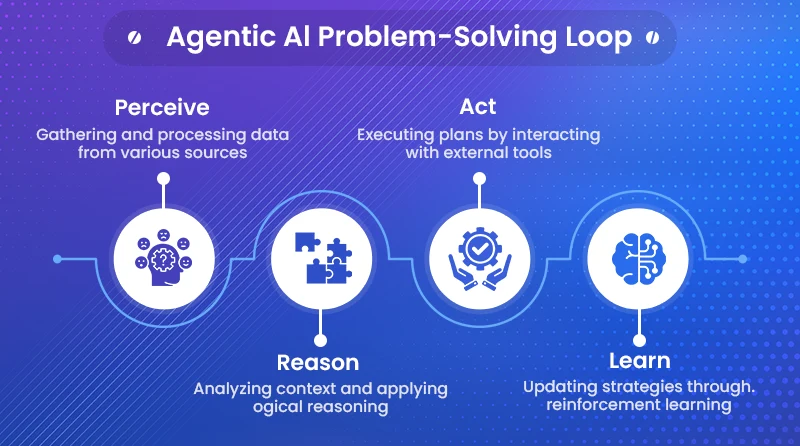
Perceive
This is the foremost process that begins with an AI agent collecting and processing data from numerous sources, like digital interfaces, sensors, and databases. The phase deals with tasks like recognizing objects, extracting meaningful features, and identifying the relevant entities in the entire environment.
Reason
This phase is generally headed by the large language model, which works as the reasoning engine to understand tasks. Once the task is well defined and easily understandable, it generates the solution while coordinating with specialized models for particular functions like visual processing, content creation, and recommendation systems. At the same time, this phase also relies on techniques like retrieval-augmented generation (RAG) that help to access the proprietary data sources to offer accurate and real-time information on the task.
Act
At this step, agentic AI executes the tasks on the basis of predefined parameters. For the same, it relies on the integration with external tools and software performed with the assistance of application programming interfaces. Moreover, Guardrails are developed in the agentic AI solution that helps to ensure that the task is executed correctly. For instance, an insurance company can deploy an agentic AI solution that can automatically process the claims up to a certain amount, however, escalate the case when the amount is higher than the defined limit.
Learn
As the name suggests, this is the final stage for the working mechanism of an agentic AI solution, where it goes through a feedback loop or can be referred to as a “data flywheel”. In this step, the data is generated from the previous task, and feedback is fed into the system, which helps to enhance the outcome efficiency during the next task. This excellence capability of agentic AI solutions to adapt the knowledge and transform to become more efficient over time bestows businesses with a powerful tool that can be relied upon for increased operational efficiency and better decision-making.
Traditional AI Agents vs Agentic AI- End-to-End Comparison
Traditional AI Agents
The traditional AI agents are basically the rule-based software programs that are curated to understand the surrounding environment, process data, and thus make decisions. Here, the entire course of action is decided only to achieve the predefined goals, which might also lead to some complexities that were not anticipated. The intelligence level of these AI agents can be optimized according to the business requirements; however, the working mechanism remains the same.
Here are the different types of AI agents-
Take reference from this link for images- https://www.ibm.com/think/topics/ai-agents
Simple Reflex Agents
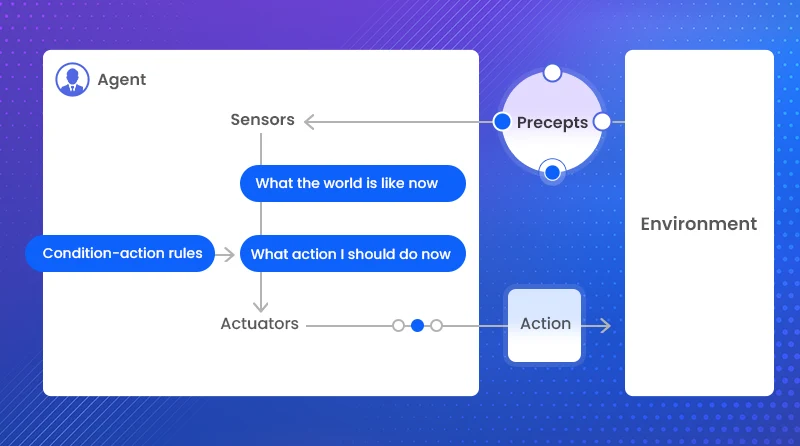
This is the simplest form of AI agents that focuses on leading the actions from on the basis of perceptions. The simple reflex agents don’t carry any memory, and thus, they can not even interact with the other agents if the particular information is messed up. This software is designed to function according to predefined rules. So, if a certain condition is being met, the simple reflex agent will execute the task.
Therefore, if there is any scenario where the predefined conditions are not being met, the simple reflex agent won’t be able to perform the task.
For instance, the simple reflex system can be used in the medical apps that will remind the patient to take the respective pills at a particular time. So, as long as the clock doesn’t hit that specific time, it won’t execute the command.
Model-Based Reflex Agents
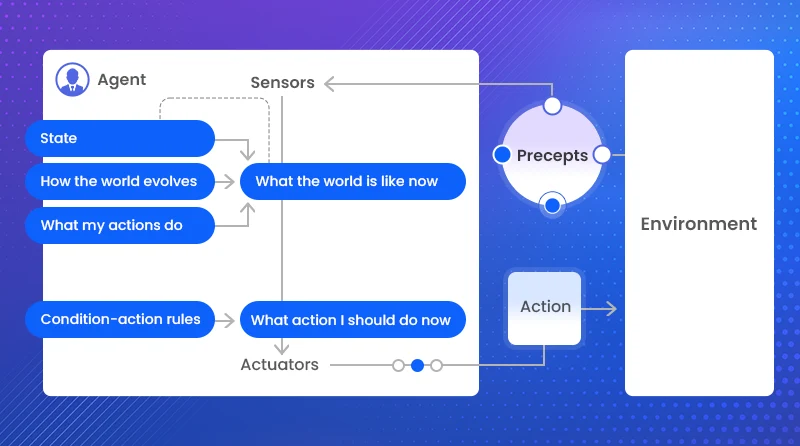
Model-based reflex agents are the more advanced version of simple reflex agents, as they carry the memory of their own memory. Thus, it relies on the current perception along with its memory to create the internal model using all the information. The model continues to update as the new information is added into the system. The action of this reflex agent is dependent on its model, current states, reflexes, and previous percepts.
The memory capability of this model allows it to operate in a dynamically changing environment. However, model-based reflex agents are still bound by their set of defined rules.
For example, an advanced medical software can be produced using this agent that only reminds the patient to take the medicine if they have had their food first. At the same time, it also ensures that the same medicine is not taken twice, reducing the chances of it getting stuck in a loop.
Goal-based Agent
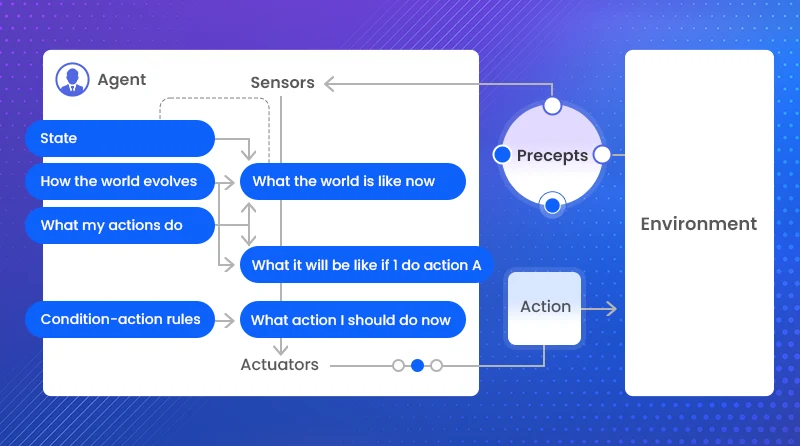
As the name suggests, the goal-based agent works diligently to achieve the defined goals without giving much importance to potential pitfalls. These agents are designed to search for the sequence of actions that leads them to reach their goals and perform the actions.
For example, a fitness app for the patient can be designed using this model. It will allow the patients to set their fitness goals. So, as soon as the agent learns about a new exercise or diet that can help achieve the goal faster, it will automatically personalize the fitness plan.
Utility-Based Agent
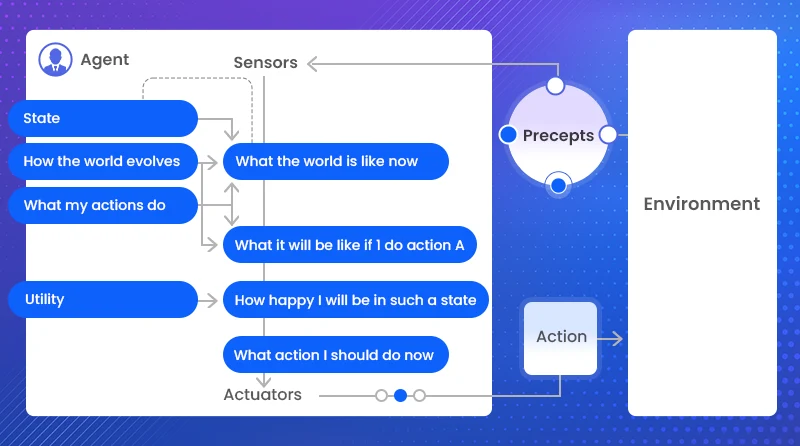
This is the upgraded version of a goal-based agent that ensures achieving the goals, but also ensures that the course of actions it chooses doesn’t cause any situation of conflict. Rather, it also maximizes the rewards and utility by calculating them through a utility function. The function allows the AI agent to measure the usefulness of an action according to different scenarios.
The entire working mechanism of utility-based agents consists of progression towards the goals, computational complexity, and time requirements. Then the agent chooses the action that has the potential to maximize the utility. Therefore, these types of agents are deployed for tasks where multiple scenarios are available to achieve the goal, and the best one has to be selected.
Taking the same example of a fitness app, if there are multiple diet plans and exercise schedules available in the dataset, this AI agent will choose the one that can achieve the goals as well as align with the everyday schedule of the user.
Learning Agents
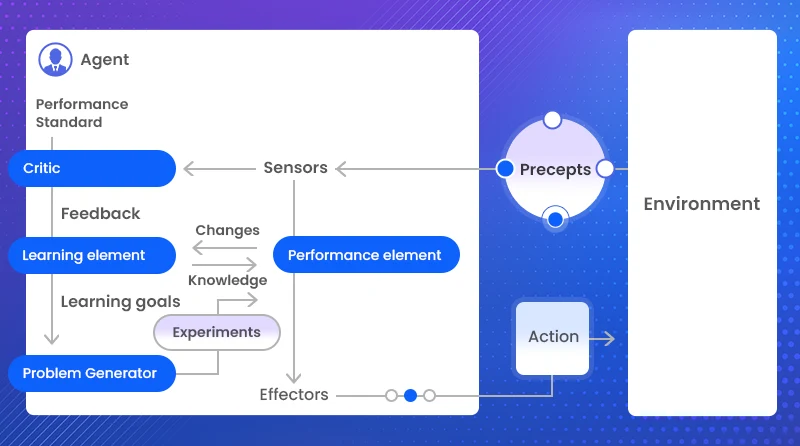
Learning agents hold the unique capability of learning through new experiences, task executions, and interaction with users. This capability helps the AI agent to add more knowledge to its database. At the same time, learning agents can easily operate in unfamiliar environments. Here are the four elements that play the key role in the working mechanism of a learning agent-
- Learning- This element is designed to allow learning agents to grab knowledge from the environment and expand their database.
- Critic- This element tells the agent whether the quality of responses aligns with performance standards or not.
- Performance- This component is mainly responsible for choosing the actions after learning.
- Problem generator- This module helps to create numerous proposals for the actions that need to be executed.
Moving toward the example, this kind of system is integrated into a highly advanced medical patient monitoring system where it actively analyzes the patient’s changing health to offer personalized tips on medications and inform the healthcare professionals about the same.
Agentic AI
Talking about the agentic AI, it is basically a complete network of multiple AI agents integrated into a unified system to perform the task. The core competency is that, unlike the AI agents, it doesn’t automate only specific tasks, but it can automate the entire process. At the same time, agentic AI solutions are designed to exhibit entirely autonomous property that eliminates or minimizes the need for human interventions in the process.
Agentic AI is also a goal-oriented system with adapting and learning capabilities, with advanced reasoning. Agentic AI solutions can handle multiple tasks or a series of tasks simultaneously while expanding their knowledge base by continuously gathering data from the environment, experience, or user interaction.
There are basically four features that make agentic AI far advanced than traditional AI agents-
Autonomous Decision Making
Agentic AI is a highly intelligent solution that doesn’t follow the simple rules to execute a task, but they have the capability to analyze the entire situation. Thus, the course of action executed by the agentic AI system is completely independent and has no interference from a human.
Goal-Driven Actions
As the terminology suggests, agentic AI solutions work to achieve certain goals. However, it doesn’t focus merely on recognizing the patterns, but it plans and carries out the multi-step tasks to achieve the goal most efficiently.
Learning and Adapting
This is one of the best features that keeps the learning window open for the agentic AI solution. Whether the data sources are interacting with the user, experiences from the previous tasks, or fetching the information from the new datasets, it consistently works on expanding the knowledge base to enhance the quality of outcomes with time.
Advanced Reasoning
Agentic AI can connect to multiple systems. Thus, it can easily collaborate with the numerous databases and tools to autonomously manage the complex workflow. This feature allows the agentic AI solution to choose the right course of action even when the situations are not favorable, dynamic, or not well-defined.
Difference Between Traditional AI Agents and Agentic AI
While the terminologies might seem to be overlapping each other, there is a huge difference in the working mechanisms and capabilities of both technologies. Let’s understand the difference between traditional AI agents and Agentic AI in an easy way-
Autonomy
The biggest difference between agentic AI and traditional AI agents lies in their autonomy capabilities. While the AI agents are designed to operate according to the predefined framework and facilitate decision-making based on the learned patterns, Agentic AI elevates the game with advanced decision-making abilities like pursuing strategic goals instead of responding merely to inputs. At the same time, agentic AI can also evaluate numerous options to make complex decisions. Continuous learning from the live environment further helps it to adapt to the dynamic conditions.
Thus, AI agents can only take actions on the deteriorating health of patients when there are well-defined symptoms. However, an agentic AI solution can even take action if a patient performs any unusual action, like striking their hands on the medical devices.
Complexity and Learning
AI agents are limited only to the tasks that follow a clear and structured pattern. However, agentic AI shows full efficiency in carrying out complex tasks by learning and adapting according to the environment. AI agents require programming updates to get new data and knowledge.
On the other hand, agentic AI solutions can learn from the user interactions and instructions. This learning ability of agentic AI is highly useful for working in a dynamic environment while adapting to the latest trends and coming up with innovative solutions to emerging business challenges.
Key Functionalities
Key functionalities of agentic AI and traditional AI agents bring other big differences. For instance, AI agents are only designed to work in predefined and structured parameters. It means that their functioning is highly limited by their training and programming. So, if there are some complications in the patient care that are yet to be trained in the model, it won’t be able to handle it that efficiently.
However, in the case of modern agentic AI solutions, it can operate on a broader scale where it combines multiple skills to handle complex processes, which might require coordination between different domains.
Action Execution
The way agentic AI and AI agents take actions is also a big point of difference between the two technologies. Individual AI agents respond to the particular request or trigger. For example, an AI agent will only call the healthcare professionals when the blood pressures rise or drops beyond the defined limit.
Talking about agentic AI, it combines multiple agents and thus, it doesn’t rely on one parameter but focuses more on performing the action even when no direct prompting has been carried out. For example, it can flag the frequent drop and rise of blood pressure to inform the healthcare professionals about the same. Here, any blood pressure level is not marked as the threshold for the system.
Strategic Planning
There is no or very limited strategic planning imparted in the AI agents, as it only focuses on achieving the goals without caring much about the circumstances of performed actions. However, agentic AI establishes coordination between the different systems to make sure that the execution of action doesn’t involve a side-impact that might impact the overall workflow. Thus, it deploys strategic planning to achieve the goals in a well-controlled manner.
| Aspects | Traditional AI Agents | Agentic AI |
|---|---|---|
| Reasoning | Domain-specific algorithms are used, including finite state machines and RI.
Example- A rule-based AI agent that answers only the defined questions. |
Reasoning based on natural language processing and large language models.
Example- An AI assistant that offers open-ended question answers while explaining the specific conditions based on the patient’s medical history. |
| Domain Flexibility | Agents are trained for a particular task.
Example- A system that only generates the reports in a predefined structured format. |
Excellent adaptability to multiple tasks without few-shot learning or manual prompt engineering.
Example- A smart bot assisting in diagnostic support by summarizing radiology reports. |
| Tool Integration | Limited tool integration.
Example- A standalone system designed specifically for identifying anomalies in CT scans and X-rays |
Easy integration with external APIs, MI, DI, MLLMs, and knowledge bases.
Example- The AI system that can be integrated into hospital legacy systems to generate lab results and offer comprehensive diagnostic insights. |
| Data & Training | Niche-oriented datasets.
Example- An AI system trained with EHR data. |
Large-scale pretraining that requires no manual retraining.
Example- An AI system that is trained on vast medical data with a capability to adapt to emerging medical terminologies. |
| Decision Structure | Rule-based decision structure with a pre-defined set of goals and actions.
Example- an AI bot that only follows the fixed guidelines for triaging emergency cases. |
Highly capable of self-directed subgoals as well as interactive planning.
Example- The AI agent that adjusts triage decisions based on patient data. |
| Explanations | Highly transparent in symbolic systems with moderate interpretability in RL.
Example- Crafting a decision tree model that offers easy understanding of the importance of certain drugs. |
Interpretability techniques are emerging.
Example- AI system interpreting the treatments on the basis of DL patterns with efforts to explain reasoning using counterfactual analysis and attention maps. |
| Primary Use Cases | Rule-based decision making, robotics, and industrial control systems.
Example- An AI robot that follows defined surgical procedures. |
Unlimited primary use cases due to high versatility and precision.
Example- Virtual assistant for patient monitoring, personalized medicines, robotic surgery, etc. |
Functional Domains of Agentic AI in Healthcare
The emergence of agentic AI has spared no part of healthcare untouched by advancements. Whether it is simply answering the queries of patients or assisting the medical professionals to analyze the visuals to identify the disease, agentic AI has already come a long way. There are diverse use cases of agentic AI solutions in healthcare, making things extremely easier, accurate, and more accessible for patients, professionals, as well as medical institutions. Here are the key functional domains of agentic AI in healthcare-
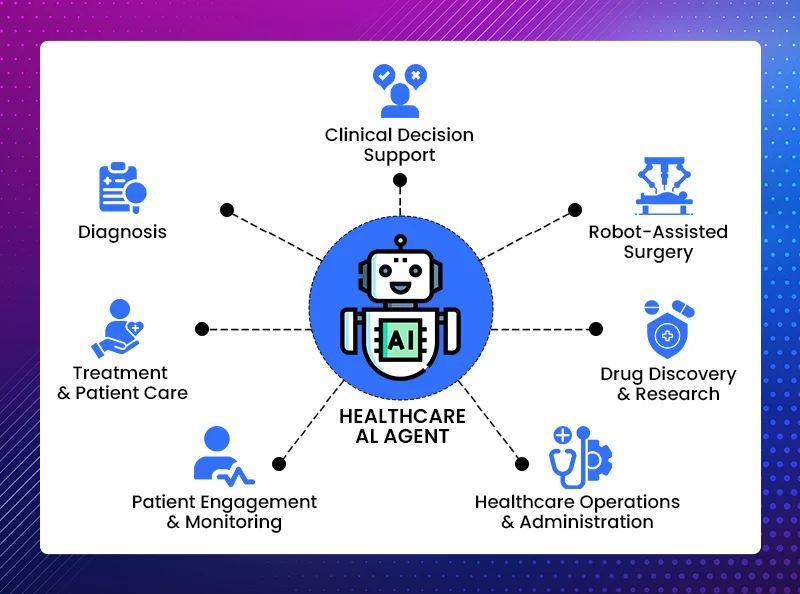
Agentic AI in Patient Care and Treatment
Agentic AI has brought significant transformation in the patient care and treatment domain, where deep learning and machine learning models are designed to analyze the genomics and clinical data of customers to curate personalized treatment plans, optimize chemotherapies, simulate drug responses, and optimize radiation therapy protocols to ensure maximum efficiency. At the same time, deep learning also helps in therapeutic optimization. Artificial intelligence embedded in the healthcare devices promises reduced errors, precision monitoring, and in-hospital patient surveillance. The systems are well designed to inform the first responders and caregivers if the patient needs help.
AgentClinic, an AI agent designed specifically for the healthcare domain, is capable of simulating doctor-patient interactions that help enormously in collecting patient information, recommending treatment, and making better diagnostic decisions. The software also requests the medical records, latest medical tests, and doctors’ dialogues to offer the right recommendation. Software like AgentClinic has undoubtedly increased the patients’ trust in AI recommendations.
Agentic AI in Clinical Decision Support Systems
AI is now integrated into clinical decision support systems (CDSS) to offer enhanced patient care. For instance, it analyzes the clinical data, behavior data, genomic data, administrative data, and information from the electronic health record system. Using the large language model, it summarizes the key findings to generate reminders and facilitate coordination between medical professionals and patients. These core competencies of agentic AI solutions help in reducing misdiagnoses, improving diagnoses, and reducing the workloads for clinicians.
Another major advancement is that the integration of agentic AI in CDSS makes it accessible to use on regular smartphones, representing the multi-agent capability. While the traditional CDSS performed tasks like summarization and information retrieval manually in different steps, the integration of artificial intelligence helps to execute these tasks while leveraging automation and increased accuracy. The software evaluates the individual AI module results to bring reliable clinical insights.
Moreover, technologies like Vision-Language Models (VLMs) integrate LLM into medical imaging, which makes it easier for medical professionals to generate structured reports while interpreting the images more accurately. A study has already explored the use cases of VLMs in radiology, including applications like augmented report view, report generation, visual search, patient imaging history highlights, and much more. At the same time, the use of VLM has brought benefits like improved workflow efficiency, better diagnostic accuracy, and reduced cognitive burden.
Talking about real-time use cases, LLaVA-Med, a VLM, was trained using the high-volume biomedical dataset from PubMed Central with a focus on integrating biomedical image interpretation capabilities and medical visual question answering (VQA) abilities. On successful testing, it was reported that the software performed better than the expectations on VQA datasets, proving its usability in assisting medical workers.
As the agentic AI solutions are evolving with time, the human-centered artificial intelligence designs as well as the regulatory considerations will become vital for usability, trust, and compliance in CDSS. There is no doubt that the integration of agentic AI in radiology has definitely reduced clinician workload, revolutionized diagnostics, and improved patient outcomes.
Agentic AI in Diagnosis
Modern healthcare institutions heavily rely on visuals like CT scans, X-rays, and medical images to diagnose disease. However, the increasing load of imaging data leaves the medical professionals too confused, which further increases the chances of human errors. Therefore, AI helps the healthcare institutions to offload the medical image analysis tasks from human professionals while ensuring the highest accuracy with speed.
AI has been enhancing the diagnostic accuracy in radiology by imparting anomaly detection, classification, and lesion segmentation. Deep Learning technologies like convolutional neural networks and vision transformers help to optimize the workflow within PACS for modalities like CT, X-ray, MRI, and pathological imaging while making sure that all the medical data is secure and safe. At the same time, MLLMs are used by AI to integrate radiology with clinical data and support the automated report generation with diagnoses.
Other than radiology, AI has also been playing an important role in analyzing pathology images, microscopic diagnoses, and enhanced cancer detection. Integrating the medical images into MLLM helps eliminate the need for manual description and thus increases the diagnosis efficiency. Med-Flamingo is a multi-model AI agent that helps in medical diagnosis by analyzing 2D images and converting texts to assist healthcare professionals. Med-Flamingo even outperformed the existing medical models by increasing the accuracy by 20%.
M3D-LaMed is another tool that is designed specifically for 3D image analysis, which integrates text-based data to enhance the diagnostic tasks. Moreover, the tool even leverages the 3D vision encoder along with a 3D spatial pooling perceiver that helps to diagnose the complex 3D scans while representing the significant advancements in AI-assisted diagnosis.
The AI models have the capabilities to keep functioning in the background without disturbing the other medical tasks and provide insightful and accurate reports the minute healthcare professionals need them. At the same time, these tools can easily flag the abnormalities and highlight them for the medical personnel to pay more attention.
Moreover, the Agentic AI solutions are further designed to leverage predictive analytics capability that helps to offer personalized care by analyzing the images, EGRs, wearable device data, and genomics. The solution focuses on identifying subtle disease indicators, including cardiovascular conditions, cancer, early signs of diabetes, and much more. The early detection of such conditions leads to better, earlier, and personalized care while optimizing resource allocation and enhancing patient outcomes. The AI models also forecast disease trajectories, model progressions, and tailor treatment plans.
However, it is highly important to integrate AI agents into clinical workflow to leverage all these advancements. Such deployment makes it easier for the professionals to identify disease, read medical images, and identify the early signs of future conditions. At the same time, for patients, the wearable devices can help track their lifestyle, offer health metrics, and recommend the best diet and exercise plans.
Agentic AI in Healthcare Operations and Administration
Deep learning and machine learning have been enhancing numerous healthcare operations by offering advanced data analysis, predictive modeling, and task automation. For instance, artificial intelligence streamlines triage in emergency departments, fosters language translation, automates patient flow, optimizes bed allocation, offers disability support, and provides a virtual assistant to healthcare staff for better management.
Moreover, AI is now even capable of handling other complex tasks like automating insurance claim processes, detecting fraudulent activities, and verifying insurance details. Predictive analysis further helps in resource management and schedule optimization by streamlining staff rostering, improving resource allocation, and establishing better operating room planning.
AI is now integrated into the internal software architecture of the healthcare institution, which helps to reduce the administrative burden of performing tasks manually under human supervision. Rather, it monitors the real-time data to prioritize the patients, coordinate transfers, and manage the bed assignments. The large language model further assists in establishing seamless communication while ensuring disability accommodation. The solution also helps medical staff with updated protocols, training, and industry best practices.
NYUTron is a practical example of this type of agentic AI solution that helped physicians as well as administrators to predict hospital readmission risks, in-hospital mortality, length of stay, and insurance claim denial chances. All these tasks helped the healthcare entities to make the right yet quick decisions. GPT4DFCI is another example of such a tool that was deployed at Dana-Farber Cancer Institute. This was a secure and HIPAA-compliant software that helped in research, administrative workflow, clinical documentation, and much more. The agentic AI solution also played a big role in addressing the challenges related to regulatory compliance, data privacy, and ethical governance.
The integration of these tools has proven how the use of AI in healthcare institutions can enhance efficiency while maintaining safety.
Agentic AI in Patient Engagement and Monitoring
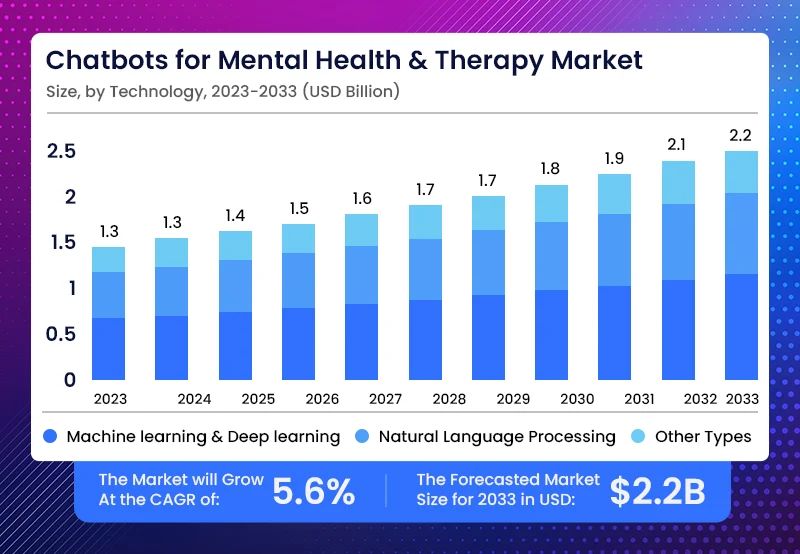
Source: https://market.us/
Not only in the technical landscape, but agentic AI has also been redefining the way patients engage with healthcare institutions and leveraging the services. For instance, artificial intelligence enables remote monitoring by collecting and analyzing the data from wearable devices like smartwatches and fitness bands. At the same time, it can also fetch information from home-based devices like sensors, cameras, and more. This information helps to detect the abnormalities, vital signs of any disease, and more. Thus, the virtual health assistance and chatbot embrace automated triage and schedule guidance to offer personalized assistance and reduce the workload of human healthcare professionals.
Artificial intelligence has also been redefining the patient engagement scenario by elevating the efficiency of video consultation, where it can analyze the patient data and offer personalized virtual care. Agent Hospital is a well-known AI agent that is designed to enhance customer engagement by simulating the interaction between a doctor and patient. A large language model agent helps to automate the consultation, triage, and follow-ups to engage the patient in medical examination, feedback loop, and dynamic dialogues.
AI agents can be seamlessly integrated into the healthcare systems and devices, which eliminates the limitations of traditional AI systems. For example, the agentic AI system can be connected to home monitoring tools as well as wearables to continuously track the patient’s behavior and alert the caregivers as soon as any abnormality or incident is reported. Moreover, features like real-time language translation, sign language interpretation using deep learning, and natural language processing further help in better communication between patients and healthcare professionals. These features significantly contribute to better patient engagement and offering personalized healthcare.
Along with physical health, AI conversational bots have proved to be highly efficient for mental health monitoring and patient engagement. Woebot, a powerful AI-supported chatbot, is a good example of the same that consistently analyzes the emotional stages of the patient using NLP to deliver empathic and personalized responses accordingly. Another study suggests the use of a large language model for mental health support, where it can adjust the response quality according to different demographic groups.
Moreover, the agentic AI system also customizes the therapeutic content by shaping its dialogue according to input offered by the user. At the same time, automated mood tracking, fluctuation detection, and user sentiment monitoring further help to encourage emotional awareness, self-reflection, and sustained participation.
Agentic AI in Drug Discovery and Research
Agentic AI has enhanced the precision and efficiency in drug discovery as it can rapidly analyze the huge compound libraries while using molecular modeling that helps to predict the interaction between biological targets. These models are trained on expert domain knowledge and extensive datasets to generate accurate results. During the clinical trial optimization, artificial intelligence analyzes the patient data to enhance recruitment, uses emerging data to design adaptive protocols, and refines the parameters to increase the success rates. At the same time, AI also processes large-scale genomic data that identifies genetic markers to enable precision therapeutics aligned to individual profiles. These kinds of innovations have already reduced the discovery timeline, encouraged advanced personalized medicines, and reduced the overall drug discovery costs.
Agentic AI also speeds up drug discovery as it can automate the complex and time-consuming process while reducing errors. For instance, the agentic AI solutions conduct high-throughput experiments that help to analyze the results to identify the promising compounds. Similarly, in clinical trials, it leverages the genomic databases and electronic health record information to recruit the right candidates, adapt protocols in real time, and streamline the overall processes. Talking about genomics, it detects disease-linked mutations, analyzes sequencing data, and suggests personalized therapies. Artificial intelligence, when integrated into the lab instruments, clinical systems, and data platforms, helps to automate decision-making, enhance overall accuracy, and encourage effective treatment.
DrugAgent has recently caught the attention as a multi-agent AI system that helps to automate machine learning programming for drug discovery. It integrates the domain-specific knowledge to enhance the key tasks, including ADMET prediction, molecular optimization, and drug-target interaction. The solution automatically generates, refines, and tests the machine learning models that help to enhance the accuracy while reducing the overall errors. DrugAgent achieved an F1 score of 0.92 in drug absorption prediction, which well-demonstrates its capability to optimize the predictive models.
Along with the drug discovery, agentic AI solutions have also been transforming biomedical research by generating, validating, and refining scientific hypotheses, leading to a lot of time saving.
Agentic AI in Robot-Assisted Surgery
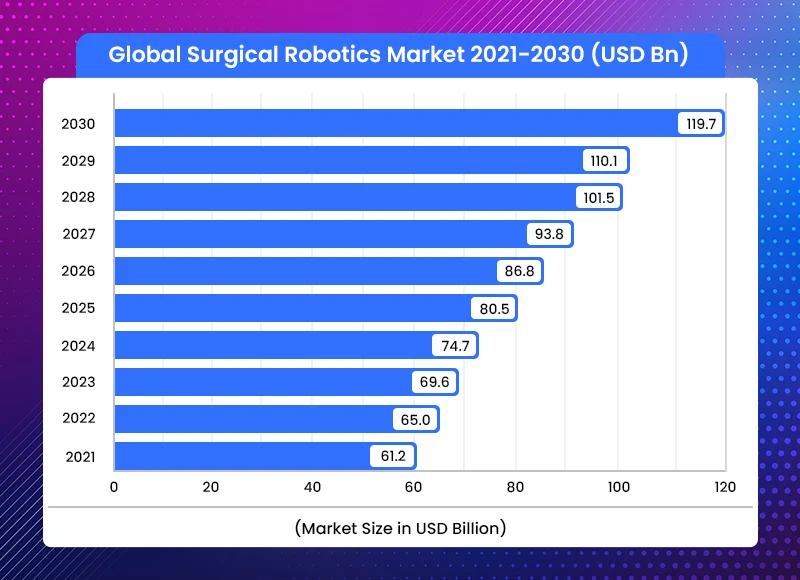
AI-powered robot-assisted surgery has set a new precision milestone while encouraging accuracy and safety in the complex procedures. It integrates the sensor data, advanced imaging, machine learning, and robotics to enable surgical robots to perform tasks while ensuring the utmost efficiency and precision. Furthermore, AI-powered instrument guidance and navigation also help to interpret the patient anatomy, optimal instrument positioning, adapt to subtle movements, and minimize overall risks. These kinds of advancements have significantly helped the surgeons to plan, execute, and refine interventions to improve outcomes.
AI agents, when embedded in robotic systems, utilize these features to analyze data from endoscopic cameras, preoperative imaging, and sensors to chart the best surgical paths. Even during the surgery, these solutions are capable of monitoring the critical parameters to identify the complications and alert the team of professionals if needed. The system automates tasks like tissue manipulation under supervision, helps in better decision-making, offers dynamic feedback, and much more. Moreover, the systems are designed to continuously learn from operations to enhance performance over time while showcasing even safer and more personalized surgical care.
SUFIA is the same kind of LLM-powered robot that translates the natural language command into low-level control actions and high-level surgical plans. It integrates the real-time perception module for consistent adaptation while ensuring safety via the HITL mechanism. During a simulated experiment, SUFIA achieved a 100% success rate in lifting a needle and a 90% success rate in handing over the needle. Talking about the physical trials, the success rates were 100% and 50% respectively. These results indicate the efficiency of AI models to optimize workflow, enhance surgical dexterity, and support the autonomous and supervised robotic interventions.
These systems operate in the interactive environment to refine the surgical strategies, adapt dynamically to the evolving scenarios, and offer intra-operative navigation. At the same time, such innovation also signals the scope of automation and the future of adaptive surgical systems in a better healthcare infrastructure.
Types of AI Agents Integrated Into a Full-Fledged Agentic AI Solution for Healthcare
As we mentioned earlier in the numerous sections, there are different types of AI agents that are integrated and connected to each other for building a full-fledged agentic AI solution for healthcare. Each of the AI agents plays a dedicated role for different healthcare categories while incorporating different AI technologies. Here are the main types of AI agents that are integrated into a full-fledged Agentic AI solution in healthcare-
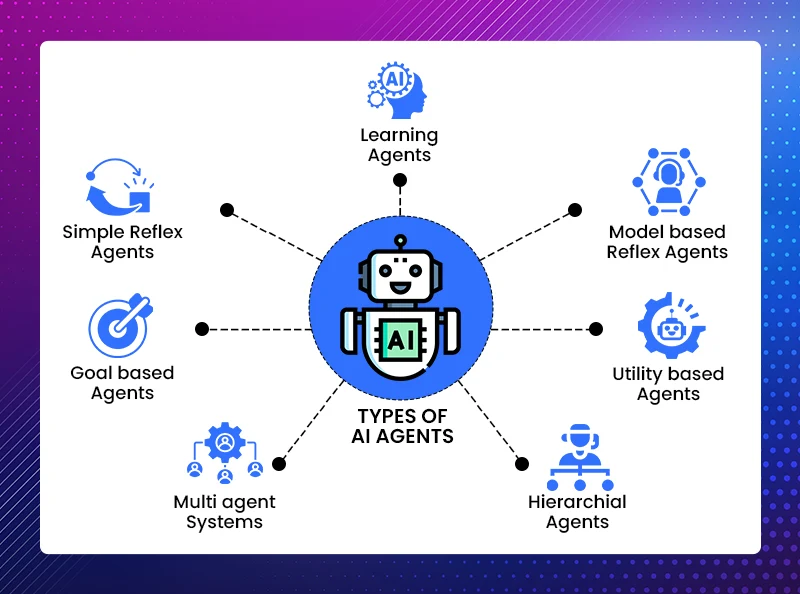
Image-Based Agents
As the name suggests, these AI agents are exclusively designed to analyze the visual inputs and help in disease diagnosis, report generation, and early detection of any potential health risk by reading the visuals like X-rays and MRIs. Image-based giants are specifically designed for the diagnosis and clinical decision support, where they help doctors and radiologists to not only save time in reading the visual reports but also ensure the accuracy and precision. There are different types of technologies used to build the image-based agents, which mainly include MLLM, CNNs, and VITs.
Predictive Analytics Agents
These AI agents are trained on a vast dataset that focuses on analyzing the existing information regarding the patient and their past health records to accurately predict the chances of diseases, health risks, and patient outcomes. Predictive analytics agents are highly used by doctors and care teams for better and personalized patient care. At the same time, these AI agents also play the core role in drug discovery & research, where they drive the data-based decision making. Technologies like predictive modeling, time series analysis, and supervised machine learning are used to build predictive analytics agents.
Conversational Agents
Conversational agents are integrated in the agentic AI solutions for healthcare that help to establish seamless communication between patients and healthcare professionals by establishing virtual consultations. This AI agent is mainly used by patients and general practitioners to enhance patient engagement and bring convenience in the remote healthcare sector. Technologies like natural language processing, pretrained large language models, and dialogue systems are used to build conversational agents.
NLP Agents
NLP agents or the AI agents based on natural language processing are curated to process the clinical notes, extract information from the unstructured & complex data, and summarize electronic healthcare record details. The NLP technology helps it to easily understand and interpret the information provided in different languages and formats. Clinical decision support, operations, and administrations are core healthcare categories that use the NLP agents to assist medical analysts and coders. Pretrained LLM and NLP are the technologies that are used to create these agents.
Rule-Based Agent
As defined previously, rule-based agents are the basic AI agents that are trained to react to a particular condition or trigger; thus, they make these tools highly helpful in alerting for drug interaction and ensuring clinical guidelines when carrying out a certain task. The tool comprises various technological systems like rule-based reasoning, knowledge graphs, logic programming, and expert rules to help doctors and pharmacists automate the particular processes.
Hybrid Agents
These are the advanced AI agents that are designed to understand the input in multiple formats, like texts, images, video, and more. The solution performs predictive analytics for better decision-making, deploys robot-assisted surgery, and helps in disease diagnosis. The software is primarily used by doctors and radiologists to interpret the patient information available in different types of formats. The solution is made up of multimodal learning that helps it to take input and provide output in different formats.
ML Agents
ML agents or machine learning agents are highly helpful in disease classification, treatment planning, and anomaly detection by accurately analyzing the patterns and identifying the changes in standard patterns. The AI agent is used for drug discovery, research, personalized treatment & patient care, and active diagnosis of diseases. The integration of machine learning, deep learning, and reinforcement learning makes it a highly useful tool for data scientists and doctors.
Recommender Agents
Recommender agents are designed to play a key role in facilitating personalized treatment and suggesting diagnostic tests. The software is made up of a recommendation system, collaborative filtering, and reinforcement learning that helps to analyze the patient information to accurately recommend the diet plans, surgical procedures, care routine, and much more. The software can even perform the duty of experienced healthcare professionals in case of the temporary unavailability of human resources.
Expert System Agents
These AI agents can emulate clinical expertise to plan patient care and offer clinical expertise at times. The agents are used for clinical decision support, robot-assisted surgery, and treatment & patient care. It is used by researchers, surgeons, and specialists to make quick and information-driven decisions while leveraging frameworks like rule-based systems and knowledge-based systems.
Challenges Associated with the Use of Agentic AI in Healthcare
Agentic AI has been redefining the way healthcare professionals carry out tasks and engage with their patients. While the remote monitoring and better resource optimization have surely brought convenience to the stakeholders, implementing agentic AI in healthcare has always been prone to some challenges that need to be addressed in order to unlock the full potential of this transforming technology. Let’s discuss some challenges of using agentic AI in healthcare-
Data Availability and Confidentiality
Because the efficiency and accuracy of AI solutions depend heavily on the quantity and quality of data used to train the AI model, it is highly important to collect data from reliable sources while ensuring the best quality. However, there are some critical challenges that developers often face while sourcing diverse and high-quality data. There are several regulatory barriers, stringent privacy barriers, and a fragmented healthcare infrastructure, which make it highly complicated for the developers and healthcare institutions to collect high-quality data. At the same time, medical records contain unstructured data, which requires Explainable AI (XAI) which ensures adherence to strict medical regulations.
The recent studies based on the use of agentic AI in healthcare have also shed light on the importance of fine-tuning large language models to extract the structured data from medical reports while complying with the relevant regulations. While LLM can definitely help in collecting the required information, fine-tuning the data, and complying with the defined legislation, its use is still a very resource-intensive and technically complex process. At the same time, it is also important that the collected data complies with evolving regulations like the European in Vitro Diagnostic Regulation (IVDR).
During the development of agentic AI solutions for healthcare institutions, any mishandling of data or oversight during the fine-tuning can lead to discriminatory decisions by the AI model. Thus, it becomes crucial to rely on diverse dataset curations, fairness evaluations, implement bias-mitigation techniques, and seamless deployment.
Data Security and Privacy
As interpreted in the earlier section, the performance of an agentic AI solution is highly based on the data used to train the model. However, as these solutions have access to large volumes of patients’ confidential data, this raises concerns of privacy and data security among the stakeholders. For instance, there were more than 725 data breaches reported to the US Department of Health and Human Services Office for Civil Rights in 2023 alone. These breaches significantly affected more than 133 million records.
At the same time, any data breach happening in the agentic AI solution also leads to vital financial losses. For example, it was reported that the average cost of one data breach worldwide is $4.88 million. The reputational damage of the organization is another concern among healthcare institutions for the use of agentic AI in their operations, which further leads to customer turnover and lost revenue.
To mitigate these issues, organizations have to implement advanced encryption practices, strictly adhere to GDPR and HIPAA, and decentralize the sensitive data storage. Also, preventive measures like regular security audits and efficient staff training are crucial.
Compliance and Legal Complexities
One of the biggest limitations in implementing agentic AI in healthcare is that the regulations in healthcare evolve at a very low pace, as compared to rapid advancements happening in the industry. Therefore, concepts like continuous learning and agentic AI models, which are entirely operative on new data, face the challenge of getting regulatory approval as the associated risk profile might evolve over time.
At the same time, LLM also brings the risk of hallucinating information that might lead to clinical errors. According to IVDR, it is crucial that AI-driven diagnostics present scientific validity, clinical reliability, analytical robustness, and meet certain compliance standards. Moreover, the robust validation and consistent monitoring of frameworks according to an ever-evolving system are also important for the patient’s safety.
Thus, it is advisable to conduct frequent model validation and performance monitoring along with introducing surveillance protocols that can track the decision-making accuracy of the system.
Integration to Existing Healthcare Workflow
Agentic AI solutions are more accessible when seamlessly integrated into the existing workflow of healthcare institutions. However, the integration process is not always smooth-going as it highly depends on the efficiency and compatibility of the existing legacy system and technology architecture. If the software and EHR system at the hospital are not designed to adopt the novel technologies, the development team often makes the required upgrades to carry out the integration. Therefore, an interactive collaboration is required between the IT team, healthcare staff, and AI developers. At the same time, it is also important that the new AI model is capable of explaining the recommendations and results, which makes it more reliable for healthcare professionals to use.
Moreover, there has always been a lack of acceptance and trust among clinicians as well as patients to completely rely on the agentic AI solutions for healthcare tasks. Therefore, it is suggested that AI models should be passed through real-world validations. Also, it has proved to be helpful to provide structured training to healthcare professionals to leverage AI-assisted decision-making.
Infrastructure & Resource Limitations
As highlighted in the previous section, agentic AI deployment in healthcare requires enormous infrastructure and computational resources. Thus, the resource-sensitive constraints, like a lack of hardware, absence of connectivity, and rural clinics, often find it difficult to leverage the advanced systems. The use of Optimizing AI Systems appears as a solution that can provide equitable access to AI solutions.
Moving ahead, implementing AI also requires a significant investment, and thus most of the small clinics and hospitals don’t prefer to explore the novel technology due to budget limitations. Therefore, the scalable and cost-effective AI options like open-source medical AI models, public funding initiatives, and cloud-based AI platforms are helpful in reducing the financial burdens without compromising accessibility.
Adversarial Weaknesses
Agentic AI systems have long been vulnerable to adversarial attacks in which maliciously crafted inputs are injected into the system using different techniques, which influence the overall outputs produced by the system. This risk is highly likely in numerous scenarios like treatment planning, diagnostics, and robot-assisted surgeries.
Therefore, it becomes important to conduct frequent rigorous testing against the threat to establish the reliability of the use of agentic AI in healthcare. Fostering the strong AI defense not only protects the outcomes generated by the AI system but also brings the trust of healthcare institutions, professionals, clinicians, patients, and other stakeholders onto the AI application across medical workflows.
Ethical and Legal Boundaries
The autonomous workflow achieved by the use of agentic AI in healthcare comes with a lot of ethical as well as legal concerns, particularly when there are chances of adverse outcomes. As the agentic AI consists of multiple models, it becomes even challenging to assign the responsibility for AI-related medical errors. However, it is highly important to assign the responsibility for these errors so that the ethical deployment of AI in the healthcare system can be ensured. Still, the lack of transparency on how these AI models make decisions makes it difficult to determine who will be responsible if the technology makes a contradictory decision and performs similar actions.
Thus, it is highly important that well-defined legal frameworks and governance mechanisms are established that can clearly define the responsibility for wrong decisions taken by agentic AI. While regulatory bodies like the FDA and the EU AI Act have already facilitated the rigorous documentation to ensure accountability for the use of AI in healthcare, an explainable working mechanism of such a solution is still required to make the process more transparent.
AI Governance and Human Oversight
The complex and autonomous nature of agentic AI eliminates the space for human oversight. Thus, it becomes highly difficult to establish human monitoring and control throughout the healthcare workflow. Recent studies have also put pressure on the need for a hybrid oversight mechanism that incorporates HITL frameworks, XAI, and rule-based intervention to ensure regulatory compliance. At the same time, different challenges like regulatory gaps, oversight fatigue, and automation bias further complicate the governance efforts in healthcare.
However, there is no doubt that using agentic AI in healthcare poses several challenges; implementing the right mitigation strategies through robust governance can bring transparency throughout the process while enabling the safer use of novel technology in the medical industry.
Tech Leaders Deploying Agentic AI into Healthcare
While the healthcare institutions around the world are already embracing the capabilities of magnetic AI in their operations, there have been certain tech leaders who have played the core role in shaping artificial intelligence into highly efficient solutions that can reshape the healthcare industry. Here are the names of renowned tech leaders who have invested dollars to shape AI for the betterment of one of the most important industries-
Salesforce: Deploying AI Agents to Transform Patient Engagement
Salesforce, the renowned customer relationship management software company, has introduced a new AI agent named Agentforce that enhances customer interactions and operational efficiency. The platform is exclusively designed to help businesses and healthcare institutions deploy AI tools for different tasks, including customer support. The application helps significantly to improve patient engagement and personalized care by connecting with patients through digital mediums. At the same time, it also enables healthcare institutions to better understand the patient requirements to offer them personalized care.
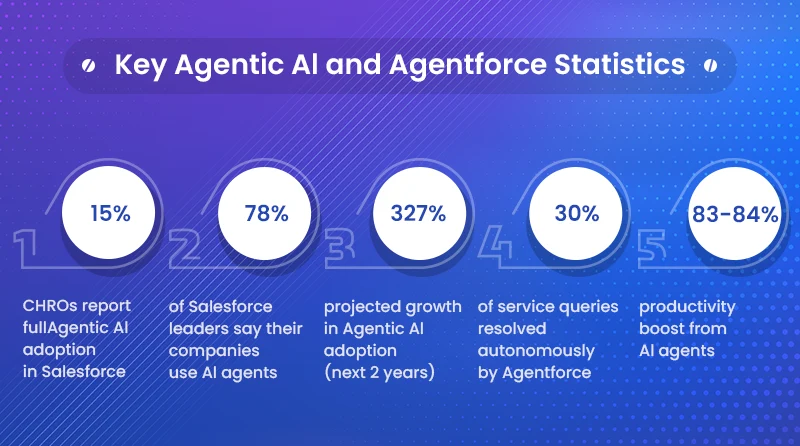
NVIDIA: Powering Advanced AI Infrastructure for Healthcare Innovation
NVIDIA has partnered with several healthcare industry leaders to build AI agents that can accelerate drug discovery processes, assist in advanced healthcare services, and enhance overall genomic research. The company has been at the forefront of transforming the healthcare delivery industry while improving patient outcomes through computational power and a platform required for complex AI models.
Microsoft: Building Autonomous AI Agents to Empower Healthcare
Microsoft has been leading the scenario of building highly efficient AI agents that can perform several tasks autonomously while elevating the operational efficiency in healthcare settings. Satya Nadella, CEO at Microsoft, introduced AI tools at the Ignite 2024 conference that are designed to act independently on behalf of users with a vision to implement the tools across the organization. The new initiative introduced by Microsoft signals the firm’s dedication to leveraging artificial intelligence to streamline healthcare processes, improve patient care, and reduce overall administrative burdens.
UiPath: Encouraging Healthcare Automation with Agentic AI
UiPath began its journey as a robotic process automation (RPA) company and is now considered one of the leading AI companies around the world that helps deploy agentic AI solutions across industries. The company introduced Agent Builder and Agentic Orchestration capabilities that help in the creation of AI agents, which can easily collaborate with human workers and software robots to enable advanced automation. These discoveries by UiPath have been reducing the administration burden for healthcare professionals, allowing them to put more time and focus on patient care.
What Does It Take for Healthcare Institutions to Implement Agentic AI- Cost and Financial Investments
Implementing agentic AI in healthcare requires significant investment, which also makes it often challenging for smaller healthcare institutions to automate their tasks using the evolving technology. However, very few know that the overall cost of implementing agentic AI in healthcare can be controlled with certain practices. For instance, the medical centers with heavy patient flow and traffic require complex agentic AI systems that can automate complicated tasks while ensuring accuracy and efficiency.
On the other hand, smaller healthcare institutions can opt for a basic agentic AI solution designed to focus on a particular task to bring automation. In this instance, the larger medical center has the capability to invest a hefty amount for an advanced and multi-agent system. Similarly, the smaller hospitals can also invest according to their potential in order to begin with the digital transformation.
Estimated Agentic AI Implementation Cost in Healthcare
The cost to build and deploy an agentic AI solution in healthcare institutions can range from $40,000 to $400,000. The development and implementation cost is highly influenced by a range of factors. For example, the complexity of a project is directly proportional to the agentic AI development cost. The simple solution requires fewer resources and expertise and thus can be developed with a few thousand dollars. On the contrary, building an advanced solution with multitasking capabilities requires a better technology stack, a larger team of developers, more expertise, and a longer time duration. Thus, the cost will automatically increase.
Here is a summary of the estimated agentic AI development cost in healthcare-
| Agentic AI Development | Estimated Cost |
|---|---|
| Custom AI Software Development | $10,000 – $20,000 |
| Infrastructure Setup Cost | $2,500 – $100,000+ |
| Clinical Decision Support System | $50,000 – $1,000,000+ |
| Virtual Agent and AI Chatbot | $20,000 – $500,000 |
| Operational Process Automation | $50,000 – $500,000 |
| Security & Compliance Infrastructure | $10,000 – $30,000 |
| Annual Maintenance and Updates | $2,000 – $4,000+ |
| Staff Training | $5,000 – $10,000 |
| Testing & Validation | $5,000 – $8,000 |
| Remote Patient Monitoring | $50,000 – $1,000,000+ |
| AI Diagnostic Imaging | $50,000 – $1,000,000+ |
| AI Integration & Implementation | $10,000 – $20,000 |
| Data Collection & Annotation | $5,000 – $15,000 |
Factors Impacting the Implementation Cost of Agentic AI in Healthcare
As interpreted earlier, there are certain factors that can increase or even lower the agentic AI development cost in healthcare. The hospitals and medical centers planning to integrate AI in their operations ought to understand these factors to control costs according to their particular needs and economic potential.
Complexity
The complex agentic AI system often requires real-time data processing, multimodal data handling to handle voice, visuals & texts, personalized recommendations, and much more. All these make the process resource-intensive intensive which further increases the development costs.
Data Requirements
The performance and quality of outputs for agentic AI in healthcare are entirely influenced by the quantity and quality of data used to train the AI model. However, if the data is not available with healthcare institutions, it has to be sourced from external resources, which often requires a payment to be paid. At the same time, data storage and processing require expensive computing capabilities, which adds to the overall development costs.
Development Expertise
Hiring a good AI development company requires a good investment. While there are several hiring models available for different types of projects, an experienced team of developers is always expensive to hire. Also, it requires dedicated experts for building, validating, and training the AI model, which increases the development cost.
Integration Costs
The new agentic AI systems demand a compatible legacy system for seamless integration. If the existing technology infrastructure is not capable of streamlined data transfer and integration, it might need an upgrade, which can also add dollars to the overall development investment.
Privacy and Security Costs
Deploying different security layers into the system needs both expertise and resources. For instance, developers need to make the software HIPAA compliant while also ensuring the key security practices like multi-factor authentication, encryption, and much more. The task increases the development timeline and ultimately the costs.
Regulatory Compliance
The agentic AI solutions, which are highly prone to different regulatory complications, need the assistance of a dedicated team of developers and law professionals. Thus, the process for legal safeguards and liability insurance increases the agentic AI development cost in healthcare.
Organizational Change Management
Hospitals and medical centers have to introduce a few drastic changes to make agentic AI an integral part of the systems. For example, it requires employee training to help them explore and use the new capabilities of the innovative system. Similarly, addressing the concern of staff and managing the organization’s shift requires the IT assistance that adds to the cost of overall development.
Post-Deployment Maintenance
Agentic AI solutions in healthcare, when deployed into the live environment, require consistent monitoring. Thus, the medical centers have to opt for technical support where the team continuously monitors the software performance and output quality. The bugs are resolved, and any errors are instantly reported so that organizational operations are not disturbed. Maintenance and support also help to provide periodic upgrades to the software to maintain the overall usability.
However, this maintenance and support is offered with a monthly or annual subscription cost that increases the investment requirement for agentic AI.
What’s Ahead- Future of Agentic AI in Healthcare?
Jacob Rouse, Amitech VP of Intelligent Automation, quoted, “If the future is about delivering more care with fewer resources—and doing it better than before—Agentic AI is your guide dog to this destination.”
The healthcare industry is undoubtedly witnessing a significant transformation with agentic AI. In the industry where the cost and resources have always been the biggest concern, agentic AI seems to be easing both. While the digital agent reduces the reliance on the human workforce, the scalability nature of the solution further lowers the cost.
There is no denying that agentic AI is highly capable of redefining how healthcare institutions will work in the near future. For instance, we might completely get rid of unnecessary chaos and long queues at the hospital reception just for appointments or ward reservations. Similarly, healthcare professionals might leverage a well-optimized work schedule to reduce burnout in their everyday lives.
Near-Term Scenarios (3-5 Years)
- Administrative Transformation- Agentic AI is already on its way to automate the administrative and front-desk tasks like scheduling, triage, prior authorization, and medical refills. AI agents are already being designed that can take care of these repetitive tasks without requiring human interference.
- Certification Pilots- We can soon expect the more formal FDA submission and transparent control on the use of artificial intelligence in healthcare and medical software. Moreover, transparency will also be expected in vendor management, medical supplies, and more.
- Human-Headed Process- Human administration is still going to be there, where the agentic AI will handle the tasks and escalate the harmful actions. Autonomy is going to be limited so that it bounds the actions taken by an autonomous system.
Mid-Term Scenarios (5-7 Years)
- Multi-Agent Ecosystem- Healthcare institutions will be dependent on the collection of specialized AI agents like imaging agent, storage agent, care-coordination agent, pharmacy agent, etc., that will be coordinating with each other within the defined protocols. The system will help them handle even the complex cases, like virtual tumor boards that can track as well as produce the care plans.
- Highly-Targeted Closed-Loop Systems- AI-powered systems that require strong RCT and prospective evidence might be witnessed in the healthcare ecosystem. For instance, insulin pumps with agentic supervision, ICI dosing subsystems, and sepsis alerts that can automatically trigger the low-risk interventions under the defined environment can be some of the innovations.
- Validation & Monitoring Tools- The runtime monitoring tools will make it easy to facilitate objective drift, continuous post-market surveillance, and better provenance logging for agent behavior.
Mid-Term Scenarios (7-10 Years)
- Wider and Safer Autonomy- As the multi-year research and development continues, the agentic AI systems may take on the higher-risk tasks like chronic disease management, diagnostic delivery, and more while ensuring audit trails, formal regulatory approvals, and insurance frameworks. However, there might be some implementation differences between institutions as well as countries.
- AI Care Department- There is no wonder that healthcare institutions might launch their dedicated AI care department specifically to handle non-serious cases and tasks like generating e-prescriptions, extracting data from medical images like CT-scans, MRIs, or X-rays, accessing medical records of the patients, and more.
Final Words
Agentic AI has been reshaping the healthcare industry by automating tasks, increasing efficiency, and bringing convenience to patients and healthcare professionals. The use cases of agentic in healthcare, like assistance in diagnosis, patient engagement and monitoring for personalized care, clinical decision support, robot-assisted surgery, treatment & patient care, healthcare operations and administrations, drug discovery & research, and much more, have made agentic AI an integral part of the industry.
At the same time, the timely upgrades in compliance and data privacy standards of the AI-based solutions have brought user trust in technological solutions. Remote patients now rely on the digital software to book their appointments, manage medical records, and even receive medical suggestions.
Different types of AI agents are now making agentic AI capable of performing not only the repetitive and data-oriented tasks but even the more complicated tasks that require critical thinking. For instance, image-based agents are designed to analyze medical visuals like X-rays, MRIs, and CT scans to accurately predict fractures, tumors, or potential diseases in the future.
However, the evolution is nowhere near the pause as the future of agentic AI in healthcare still has a lot to unveil, with the potential to entirely redefine the medical facilities from what we perceive today.


